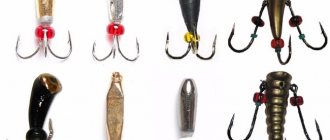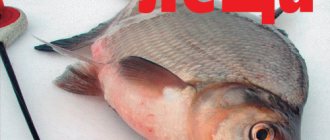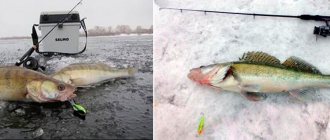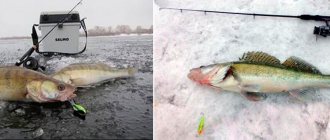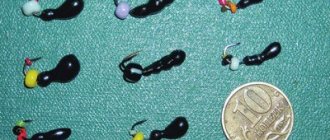Devil fishing line
Many devil fishermen have a minimum line thickness of 0.15 mm, and when they are lucky enough to run into a fattening school of pike perch or large perch, they use a line of 0.2 mm or even thicker.
Naturally, you can’t put a light bait on such a “rope”, since you won’t be able to play with it normally, so they use heavy devils weighing 1-2 g. Of course, a sufficiently powerful tackle for winter does not mean at all that it is rough and insensitive. After all, quite a lot of other equipment elements are used to make it harmonious and obedient.
You can choose a fishing line that is rigid and preferably sinking. Rigid fishing line tangles much less in the wind. In addition, it has little stretch and more clearly conveys bites from the depths. For the same reason, it is preferable to use a sinking line. The lack of buoyancy reduces the friction of the fishing line on the water, thereby improving the game of the reelless fish, and careful fish bites are much more noticeable.
Choosing a Rod and Reel
For a fairly powerful tackle and, accordingly, a heavy jig, devil fishermen try to choose not a “universal”, but a specialized nod for a strictly defined weight of the jig. The universal, as we know, is often the enemy of the good. In powerful gear, so that it does not turn into rough, all elements must strictly correspond to each other and work like a clock.
Having tried many materials, a considerable part of fishermen opt for a steel watch spring. For greater efficiency, grind it into a cone. The length of the working part of the nod is about 10-16 cm. Small passage rings are soldered on the tip of the nod (sometimes in the middle). If the ring freezes in severe frost, then lubricate it with Vaseline.
Some fishermen use cork handles on fishing rods (can be cut from an old spinning rod) 20-25 cm long. They also use a vinyl plastic whip of this length. A plastic reel with a spool with a diameter of 5 cm is mounted in a spinning reel seat. Such a long fishing rod is very convenient when fishing for pike perch. They can lift the bait as high as possible from the bottom soil (a frequent requirement for the devil), and hook it with a wave of the brush even at a considerable depth.
The reel may seem too primitive, but attempts to use multipliers were not successful - these reels are too capricious in the cold, and it’s a pity to throw such an expensive thing into snow or ice.
Techniques and tactics of catching devils
Fishing tactics involve actively playing with bait. This is best done in pre-tested areas of the reservoir.
Fish usually accumulate in the edges, in flooded ditches and streams, and mounds. Such places are usually familiar to local fishermen for a long time. As a rule, 10 -15 holes are drilled in a straight line and these holes begin to be fished.
Good to know! The fishing process consists of playing with a devil with periodic breaks. The game consists of rhythmically raising the bait to a height of up to 50 centimeters with a slight sway of the rod. After this, the devil sinks to the bottom, there is a pause and everything repeats again.
Wiring Features
The peculiarity of wiring lies in the special technique of holding the rod.
There are two capture methods:
- Straight.
- Lower
If the fishing rod is equipped with a handle, then both options are possible.
Tips for catching devils
- This bait is very similar to a lure. This is a fish delicacy that is a dragonfly larva. That is why during the period of active fish feeding the devil is so popular
- The main thing to remember is the correct nod setting, the sensitivity of the gear and, of course, the fishing technique. The nod for catching devils must be elastic, made of a steel plate or a clock spring. The most reliable length of a nod cut into a cone is 70-100 mm, the ratio of the width of the upper part and the base is 1:2. Such parameters will ensure its stability even in fairly strong winds.
- The intensity of the rise of the jig, as well as the frequency of oscillations, should be selected experimentally on the reservoir. It is believed that for predatory fish this value should be 250 vibrations per minute. For roach, the frequency is 50-150 vibrations per minute.
This type of fishing is a very interesting activity. Anyone can easily master this fishing technique if they wish.
Variety of devils
There are a huge variety of devil jigs. Fishermen with considerable experience, having tried almost all known designs, came to a paradoxical conclusion: you can fish with anything, as long as the tackle is balanced and, first of all, the nod is correctly selected. But some devils also have disadvantages, or rather features.
For example, there are baits hanging on a fishing line at an angle that sometimes reaches 45 degrees. They make it easier to diversify the game, and the number of empty bites is significantly reduced. But such a bait regularly clings to the lower edge of the hole, and this often ends in offensive derailments and line breaks.
The hooks on the devils usually protrude beyond the body of the jig, but there are models with non-protruding hooks. Protruding hooks are more reliable when hooking, but it is impossible to fish in snags with a jig with such a hook. But this is one of the favorite habitats of large pike perch. Straight-hanging devils, in which the small tee does not protrude beyond the body of the bait, are capable of working without hooks in the most difficult conditions, but there are quite a lot of derailments from them... The choice is up to the angler.
Features of catching bersh
In winter, the bursh lives in deep parts of the reservoir; it prefers to stay in holes at a depth of more than 8 meters, in which there is a current. As a rule, it is impossible to find it in shallow waters during the winter.
In severe frosts, schools of bersh can be found at a depth of about 15 meters. Occasionally, in search of food, the bursh comes out to the edges; in such places the depth is very small, about 4 meters.
In principle, when catching pike perch, you can also catch bursh, since their diet is similar. The difference is that the bursh prefers to stand on the sandy bottom; quite often it sticks to the fairway and riverbeds. Bursh feeds from the bottom, its diet includes various worms and small fish, and there is no point in catching bersh in half-water. It is best to select bait for catching bersh in winter based on weather conditions.
The peak activity of bersh in winter occurs in the morning; from 08:00 in the morning to 12:00 in the afternoon, frequent bites of bersh are observed. After this there is a short break and closer to 17:00 in the evening the bite resumes. Fishing for bersh in winter is also possible at night, but according to anglers, it is ineffective.
Here's what you need to know: Trout Spoons-Buy Cheap Trout Spoons lots from China Trout Spoons suppliers on Aliexpress.com
The most catchy bait for catching bersh from ice is a white or yellow spinner. In winter, it is best to fish with a bersha jig in places where there is no current or it is insignificant. In addition, catching bersh in winter is possible using a balance beam, sprat and silicone baits.
Choosing jig color
There is a generally accepted opinion that the color of devils does not affect their catchability, therefore the traditional color for classic devils is black.
There are also green, yellow, red and many other colors of devils, but this whole rainbow is more designed for the fisherman than for the fish. The same can be said about multi-colored dots, “fish eyes” and stripes on the body of jigs.
Various additions to devil hooks have a much more noticeable effect on the pike perch bite. This could be beads, pieces of cambric, etc. The original bait is a strip of silicone or rubber made from an inflatable ball, 15-20 mm long and 2-3 mm wide, which is placed on one of the hooks of the devil’s tee. Sometimes it’s a good idea to put a white or yellow bead on the fishing line before tying a jig so that it slides freely along it.
Equipment Features
The fishing rod for this kind of fishing is different from the usual one with a jig. The following requirements must be met: certain requirements.
Rod
Basic requirements for a fishing rod:
- The fishing line installed on the rod should have a thickness of 0.08 to 0.14 millimeters.
- The presence of a coil is a must.
- The rod should have a comfortable handle and an acceptable light weight.
- The nod must be installed elongated and with the required stiffness coefficient.
These requirements are determined by the characteristics of fishing for devils. Winter fishing conditions usually do not involve sitting in one place for a long time. You will have to look for fish, which is why the fishing rod should be easy and quick to assemble and disassemble.
In this case, a fishing rod and reel is simply the best option. Also, snow does not stick to the reel in winter, which is also of great importance.
Nod
The nod should be, as already described above, a special elongated one. This design of the nod is necessary to ensure the required amplitude of vibration of the bait. Also, a long nod smooths out incorrect movements of the novice fisherman’s hand.
The nod material should not change its performance properties under the influence of negative temperatures. The most popular are metal nods, but what about lavsan options with a length of 15 - 20 centimeters.
If necessary, the nod can be bent at the required angle. This is done to specifically adjust the fishing rod to suit you.
fishing line
A line with a maximum cross-section of 0.14 millimeters is used to transmit vibrations from the rod to the bait. If you use a thicker fishing line, the quality of vibration transmission will noticeably decrease. In addition, a thick fishing line will be visible to the fish, which will negatively affect the outcome of the fishing.
According to the design of the fishing line, it can be:
- Wicker.
- Monoprofile.
You can use any at the request of the fisherman.
It is precisely because when using the devil tackle, the fishing rod is equipped with a thin fishing line, and there is no possibility of installing a leash, it is impossible to catch a pike with this tackle. The toothy predator simply cuts off the devil when attacking, because it has very sharp teeth.
From the stories of experienced fishing masters using such gear as the devil, it is known that of the predatory fish you can catch perch and pike perch with it, but no one has caught pike.
Technique for catching pike perch using a devil
Most often, pike perch is tempted when the “devil” is led quite quickly from the bottom, giving it jerky movements with a nod. Sometimes the fish likes a different game: the “devil” is raised very slowly, causing it to tremble finely and intensely in the water, the jig seems to hang in one place. Quite often, pike perch grabs the bait when it sways smoothly at the very bottom or five to ten centimeters from it. When retrieving, it is useful to stop the bait for a second or two from time to time - this can also provoke the pike perch to bite.
I would like to give one more piece of advice to novice fishermen: try to remember as accurately as possible which game the bite occurred. The fact is that when fishing for a “devil”, it is especially important not to lose the right game: you are unlikely to immediately achieve another catch if even the slightest glitch occurs in your actions and you change the game of the reelless one.
It happens that pike perch is provoked by the rhythmic swaying of the devil not in the vertical, but in the horizontal plane. It is better to perform such complex manipulations at the same distance from the bottom at which the last bite was recorded.
Video
Catching roach on the devil video
Large roach on Ukolov's little devil video. First ice.
Lessons on catching bream using a devil from a pro video
How to catch devils in winter video
In this video I talk about the winter fishing rod and show not only the structure of the fishing rod, but also some of its subtleties. In addition, I show with examples how to catch perch with a devil in winter fishing. You can fish with such a fishing rod both with a bloodworm and without a bloodworm jig. Thanks to the high-quality game of the devil, you can catch perch, chebak, bream and other fish in winter fishing. If you change the jig, you can easily catch live bait for pike fishing. But the most effective fishing for devils occurs precisely with perch, and you can catch very large perch with it even without a bite.
